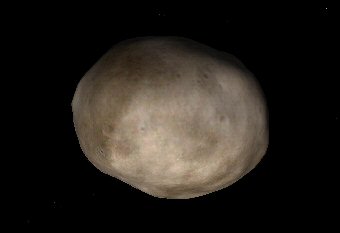BY LETTER
Planetoid Class
 Image from John M. Dollan |
Generally, rocky, metallic and/or icy bodies, either irregular or regular in shape. These may be large asteroids, moons, dwarf planets or deep space objects; generally about 51 to 1,000 km along the longest axis. These small worlds also tend to be more spherical in shape, reflecting their larger sizes and greater gravity. The maximum mass for a planetoid is 0.05 x Earth's mass, intermediate between Asteroidal and Terrestrial Classes.
There are minor planets in every solar system, bodies that represent the embryos of growing planets in a young solar system, and the still born remains of planets in old systems. Yet, despite their small size, these worlds are capable of possessing unique characteristics in nearly every facet that the larger, Terrestrial planets have. Most have barren, cratered surfaces, but many possess surface deposits of ice, and some even have tenuous atmospheres.
In most cases, Planetoidal bodies initially begin to form in independent orbits, and seem to be well on the way to forming a true planet. However, various circumstances can arrest this development, and either leave the Planetoid alone in a planetary orbit, or surrounded by other Planetoids and asteroids, as in a belt. In the Sol System, for example, the Asteroid Belt contains many Planetoids, the largest of which is Ceres. Quite possibly Ceres, or its large cousin Vesta, are the remnants of a failed planet. Other Planetoids can form in the furthest reaches of a solar system, and make up the majority of objects to be found in the local Kuiper belt. Some of these may find their way into the realm of the outer planets and remain as wanderers, or even be captured and become Jovian moons.
Types of Planetoid
Related Articles
Appears in Topics
Development Notes
Text by John M. Dollan in his Planet Classification List
Initially published on 19 December 2001.
Initially published on 19 December 2001.






